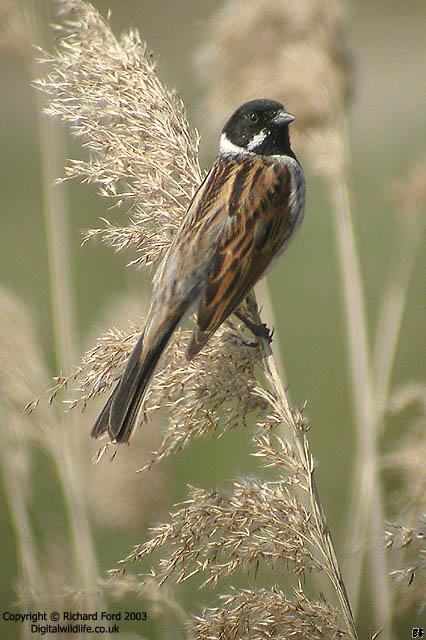(Increased picture size) |
(Flight photo. Some sections expanded) |
||
| Line 4: | Line 4: | ||
;[[:Category:Emberiza|Emberiza]] schoeniclus | ;[[:Category:Emberiza|Emberiza]] schoeniclus | ||
==Identification== | ==Identification== | ||
| − | 13.5-15.5 cm | + | 13.5-15.5 cm<br /> |
| − | + | '''Breeding Male''' | |
| − | The '''female''' | + | Black head and throat, white neck collar and underparts, heavily streaked brown back, deeply notched tail with white edges.<br /> |
| + | In '''winter''' the black is obscured by rufous-buff edging. | ||
| + | The '''female''' and ''immature''' are much duller, though still heavily streaked, lacking the black head and white collar. A buff supercilium. | ||
| + | Legs and stout bill brown. | ||
====Similar species==== | ====Similar species==== | ||
[[Pallas's Bunting]] from eastern [[Siberia]] looks similar. However it's smaller, longer-tailed, the plumage is generally paler and it has a pale rump. | [[Pallas's Bunting]] from eastern [[Siberia]] looks similar. However it's smaller, longer-tailed, the plumage is generally paler and it has a pale rump. | ||
| Line 14: | Line 17: | ||
[[Image:reedbunting_female.jpg|thumb|350px|right|Photo by {{user|postcardcv|postcardcv}}<br />Female]] | [[Image:reedbunting_female.jpg|thumb|350px|right|Photo by {{user|postcardcv|postcardcv}}<br />Female]] | ||
==Habitat== | ==Habitat== | ||
| − | + | '''Breeds''' in almost any kind of marshy place: reedbeds, river banks etc but in ""winter''' will be found on farmland, particularly stubble fields. | |
==Behaviour== | ==Behaviour== | ||
| + | [[Image:Reed Bunting21.jpg|thumb|350px|right|Photo by {{user|targetman|targetman}}<br />[[Lincolnshire]] [[UK]] June 2008 ]] | ||
| + | Forms mixed flocks in winter with other buntings and finches. | ||
====Diet==== | ====Diet==== | ||
Its diet includes seeds and insects when feeding young. | Its diet includes seeds and insects when feeding young. | ||
| Line 21: | Line 26: | ||
They lay 4-7 eggs in a nest which is built in a bush or reeds | They lay 4-7 eggs in a nest which is built in a bush or reeds | ||
====Vocalisation==== | ====Vocalisation==== | ||
| + | '''Song''': repetitious "tseek, tseek, tseek, tissick". | ||
<flashmp3>Emberiza schoeniclus (song).mp3</flashmp3><br /> | <flashmp3>Emberiza schoeniclus (song).mp3</flashmp3><br /> | ||
''[[Media:Emberiza schoeniclus (song).mp3|Listen in an external program]]'' | ''[[Media:Emberiza schoeniclus (song).mp3|Listen in an external program]]'' | ||
==References== | ==References== | ||
| − | Wikipedia | + | #Wikipedia |
| + | #Birdwatchers Pocket Guide ISBN 1-85732-804-3 | ||
| + | #Collins Pocket Guide to British Birds 1966 | ||
| + | #Collins Field Guide 5th Edition | ||
==External Links== | ==External Links== | ||
{{GSearch|Emberiza+schoeniclus}} | {{GSearch|Emberiza+schoeniclus}} | ||
Revision as of 18:57, 24 March 2009
| This article is incomplete. This article is missing one or more sections. You can help the BirdForum Opus by expanding it. |
Alternative name: Common Reed Bunting
- Emberiza schoeniclus
Identification
13.5-15.5 cm
Breeding Male
Black head and throat, white neck collar and underparts, heavily streaked brown back, deeply notched tail with white edges.
In winter the black is obscured by rufous-buff edging.
The female' and immature are much duller, though still heavily streaked, lacking the black head and white collar. A buff supercilium.
Legs and stout bill brown.
Similar species
Pallas's Bunting from eastern Siberia looks similar. However it's smaller, longer-tailed, the plumage is generally paler and it has a pale rump.
Distribution
Taxonomy
Habitat
Breeds in almost any kind of marshy place: reedbeds, river banks etc but in ""winter will be found on farmland, particularly stubble fields.
Behaviour
Forms mixed flocks in winter with other buntings and finches.
Diet
Its diet includes seeds and insects when feeding young.
Breeding
They lay 4-7 eggs in a nest which is built in a bush or reeds
Vocalisation
Song: repetitious "tseek, tseek, tseek, tissick".
<flashmp3>Emberiza schoeniclus (song).mp3</flashmp3>
Listen in an external program
References
- Wikipedia
- Birdwatchers Pocket Guide ISBN 1-85732-804-3
- Collins Pocket Guide to British Birds 1966
- Collins Field Guide 5th Edition
External Links






